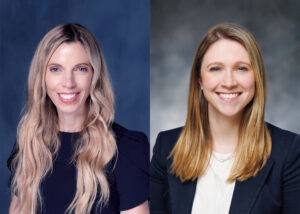
The BEST-CLI trial underscores the importance of ensuring trainee competence in open peripheral revascularization as well as endovascular treatment. Indeed, the trial results have called for a reshift in focus to ensure trainees have much needed open skills.
That’s because, for selected patients, “Bypasses are actually very relevant.” So says new, multi-institutional data to be showcased on Friday in Plenary Session 5 (8–9:30 a.m. in the West Building, Level 3, Skyline Ballroom), which reveals that trainees do face the future with parity in their graduating operative autonomy and competency in both approaches. Erin Buchanan, MD, a vascular and endovascular fellow at the University of Virginia, Charlottesville, and presenting author of the study, and Libby Weaver, MD, assistant professor of surgery and assistant program director at the same institution, and senior author, spoke to VS@VAM about why these data matter.
“The utilization of endovascular procedures for peripheral arterial disease [PAD] treatment has significantly increased over the years, but open procedures still have a really important impact in vascular care—bypasses are really very relevant. We’re trying to ensure that all vascular trainees, whether they are integrated, or follow the traditional pathway of general surgery training and vascular fellowship, are appropriately achieving competence both in endovascular and open procedures to achieve the right balance in training and patient care,” Buchanan said.
Their study’s conclusion shows just that. “There is no difference in the graduating level of autonomy and competence of endovascular compared to open peripheral revascularization procedures for vascular surgery trainees.”
The big picture takeaway results and specific numbers that are striking, says Weaver, are “assuming average-case complexity and a typical resident, rater and program; the predicted probability of a graduating resident or fellow being rated as autonomous was 96% for endovascular cases and 97% for open procedures. The predicted probability of a graduating resident or fellow being rated as competent was also similar for these cases at 88% for endovascular and 86% for open procedures. In other words, there’s no difference in predicted autonomy or competence upon graduation between open or endovascular cases when trainees perform average complexity peripheral vascular revascularization.”
Buchanan says: “These data are reassuring because vascular surgeons want to confirm that we’re creating safe surgeons who can capably use all the tools in their toolbox and use the wide breadth of their knowledge to take appropriate care of patients. In the setting of appropriate complexity cases, this dataset supports that trainees are ready to care for those patients, no matter what approach they need to use.”
Weaver pivots to those more complex PAD procedures. “When we looked at the most complex procedures, there was a slightly lower level of predicted competence achieved. In those situations, about 70% of the time we expect graduating residents and fellows to be able to competently perform complex procedures, whether they are open or endovascular, which just means that we should expect that with complex cases; even in independent practice, there’s a degree of ongoing mentorship needed.” Buchanan adds: “It’s also not unexpected that in situations where trainees are going out into practice and doing complex cases, they may need assistance from their senior partners.”
Weaver explains that these data follow hot on the heels of a recently presented dataset of nearly 5,000 assessments of open and endovascular procedures for fellows and residents at the Society for Clinical Vascular Surgery (SCVS) annual meeting in March that also show “in general, across the board, our residents and fellows, while they follow two unique pathways, seem to be equally prepared to do open and endovascular procedures.”
Outlining the need to capture more nuanced information on true competence rather than just case volume, which Buchanan suggests is merely a surrogate marker of competence, the researchers used the operative performance and autonomy ratings for infrainguinal endovascular and open revascularizations from the Society for Improving Professional Learning (SIMPL) application database for all vascular surgery participating institutions from 2018–2023.
The Vascular Surgery Board (VSB) is supporting the use of this app, which will help implement Entrustable Professional Activities (EPA) for all trainees. While the use of the app is not a requirement, Weaver notes that it will likely be used widely, with required EPA implementation anticipated in early Fall. This dataset, along with a pilot study already underway, is, therefore “a preview of the type of information we can get for our trainees and the way that we can give our trainees good assessments and feedback to help them improve their technical skills and measure pre- and post-operative management of patients as well,” she says.












